Spanish Euro Coins
Spain was one of the founding members of the Euro zone and started issuing coins in 2002. Some basic facts relating to Spain.
Spanish Euro Coins have many interesting features, including the "Raised Arc" feature of the early coins and the "Cultural Heritage" Commemorative Series.
Normal Currency Coins.
As with many other countries in the Euro zone , Spainish Euro Coins are devided into three groups - one for the "copper coloured coins"(1 cent,2 cent and 5 cent), one for the "gold coloured coins" (10 cent,20 cent and 50 cent) and finally one for the one Euro and two Euro coins.
The first motif (1,2 and 5 cent coins) is the Cathedral of Santiago de Compostela which contains the grave of the Apostle Jacob.
The second motif (10,20 and 50 cent coins) is Miguel de Cervantes the most renowned Spanish literary figure - author of Don Quixote.
The third motif (1 and 2 Euro coins) is reigning monarch Juan Carlos I.
The design of the Spanish coins was slightly modified in 2010 to bring them in line with the new guidelines.
Previously some of the "* "(stars) were embedded in a sort of raised arc. On the 1 Euro and 2 Euro coins name "Espana" was also on a raised arc. These raised arcs have been removed and the stars now appear as in the European flag.
The year which previously appeared under the king and was in the "star arc" now appears to the left of the king in the inner disc.

The raised arc appeared from 8 o'clock to 12 o'clock in the 1,2 and 5 cent coins.

The raised arc appeared from 12 o'clock to 3 o'clock in the 10,20 and 50 cent coins.

The raised arc appeared from 1 o'clock to 4 o'clock in the 1 Euro and 2 Euro. In addition the raised arc on which "Espana" was imprinted has been removed.

New positioning of date as from 2010.
If a minting series is taken as the issue of the coins from one cent to two euros where there is a difference in some of the coins other than the year issue, then one could say that Spain has four series. View the table below:
Spanish Minting Series
| Period | Description | |
| from 1999 to 2006 | Old Common Side and Old National Side | |
| from 2007 to 2009 | New Common side and Old National Side | |
| from 2010 to 2013 | New Common Side and New National Side(with raised arcs removed) | |
| from 2014 | New Common Side and National Side with the new king - Phillipe |
Old Series |
New Series |
2014 Series |
||
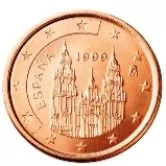 |
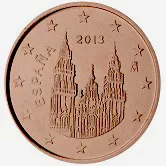 |
 |
||
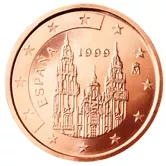 |
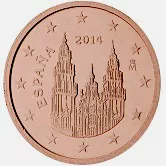 |
 |
||
 |
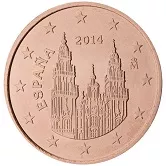 |
 |
||
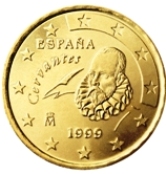 |
 |
 |
||
 |
 |
 |
||
 |
 |
 |
||
 |
 |
 |
||
 |
 |
 |
Coin motifs.
The one, two and three cent coins have as their motif - Cathedral de Compostela.
The ten, twenty and fifty cent coins have as their motif - Miguel de Cervantes
The one and two Euro coins have as their motif the head of the reigning monarch - until 2013 Juan Carlos I and from 2014 Felipe VI.
As from 2010 all the raised arcs were removed and in addition in the one and two Euro coins the mint mark was moved from between seven and eight o'clock to between three and four o'clock and the year of issue was taken from the outer ring and placed at eight o'clock in the inner circle.
Two Euro Coin Rim
Around the rim of the Two Euro Coin appear the number "2" followed by "**".
This
repeated six times so that the "12-Star" European motif is represented.
Each "2" is inverted with respect to the preceding and following "2".
Spanish Commemorative Two Euro coins.
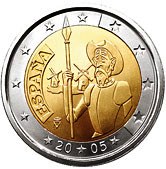
2005 - Commemorated is the 400th anniversary of the publication of Don Quixote one of the most famous characters in literature with two of the windmills (giants) he charged.
Date of issue : 30.06.2005
Issuing Volume : 8 Million
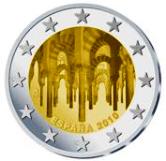
2010 - The Mezquita (Mosque) and old town of Cordoba are depicted. This is the first coin in the Spanish World Heritage Series.
Date of issue : 03.03.2010
Issuing Volume : 8 Million
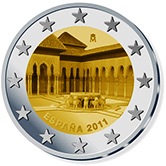
2011 - The Patio de los Leones (Court of the lions) in the Alhambra in Grenada is depicted.
Date of issue : 28.01.2011
Issuing Volume : 8 Million
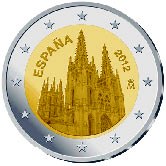
2012 - Burgos Cathedral.
Date of issue : 01.03.2012
Issuing Volume : 8 Million
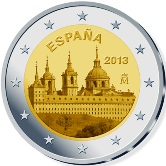
2013 - This fourth coin in the Spanish world heritage series represents the San Lorenzo del Escorial Monastery.
Date of issue : 02.03.2013
Issuing Volume : 8 Million
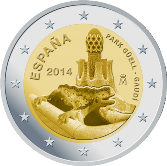
2014 - This fifth coin in the Spanish world heritage series. Park Güell is represented by a lizard sculpture and a detail of one of the pavilions.
Date of issue : 07.02.2014
Issuing Volume : 8 Million
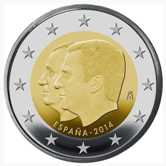
2014 - Succession to the Throne of King Filipe VI.
Date of issue : 10.12.2014
Issuing Volume : 12 Million
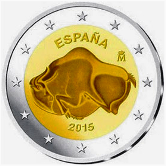
2015 - Cave of Altamira and Paleolithic Cave Art of Northern Spain.
Date of issue : February/March 2015
Issuing Volume : 8 Million
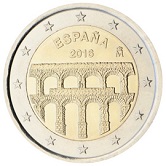
2016 - Aqueduct of Segovia - now a UNESCO World Heritage Site.
Date of issue : 29.02.2016
Issuing Volume : 8,000,000
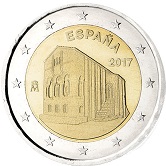
2017 - Santa Maria del Naranco Church now a UNESCO World Heritage Site.
Date of issue : 15.02.2017
Issuing Volume : 4,000,000
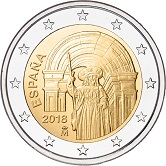
2018 - Old Town of Santiago de Compestela now a UNESCO World Heritage Site.
Date of issue : 02.02.2018
Issuing Volume : 300,000
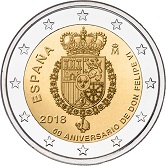
2018 -
50th Birthday of King Felipe VI
Date of issue : 02.02.2018
Issuing Volume : 400,000

2019 - Commemorated
with this coin is the construction of city wall of Ávila.
Date of issue : 01.02.2019
Issuing Volume : 1,000,000
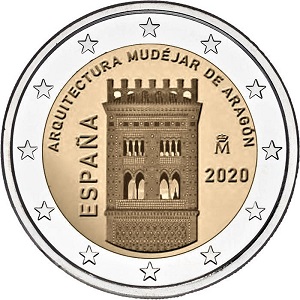
2020 - Architectur of the Mudéjares in Aragon.
Date of issue : 31.01.2020
Issuing Volume : 4,000,000
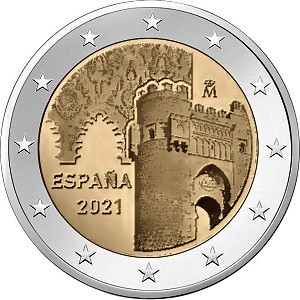
2021 – Old Town of Toledo.
Date of issue : 10.03.2021
Issuing Volume : 4.000.000
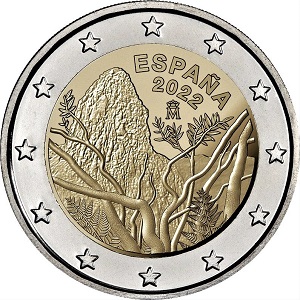
2022 - Issued in honour of the National Park Garajonay.
Date of issue : 23.03.2022
Issuing Volume : 1 Million
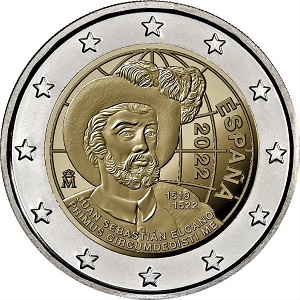
2022 - Commemorates the 500th anniversary of the first circumnavigation of the earth by Juan Sebastián Elcano.
Date of issue : 23.03.2022
Issuing Volume : 1 Million
Return from Spanish Euro Coins to Links to Specific Countries.
Return from Spanish Euro Coins to euro coin collector.